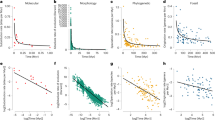Abstract
Systematics is a multipurpose endeavour and is constantly becoming more complex. No longer are we solely concerned with describing the diversity of nature but, among, other things, we have the responsibility (and, increasingly, the capability) of organizing this data base for use by other biologists. This demand for organization requires that we interpret our data in an attempt to reconstruct a reasonable approximation of evolutionary history and relationships.
Access this chapter
Tax calculation will be finalised at checkout
Purchases are for personal use only
Preview
Unable to display preview. Download preview PDF.
Similar content being viewed by others
Literature
Brown, D. S., Jr., P. M. Sheppard & J. R. G. Turner. 1974. Quaternary refugia in tropical America: evidence from race formation in Heliconius butterflies (Lep., Nymphalidae). Proceedings of the Royal Entomological Society of London, Ser. B, 187(1088): 369–378.
Doyen, J. T. 1973. Systematics of the genus Coelocnemis (Coleoptera: Tenebrionidae), a quantitative study of variation. University of California Publications in Entomology 73:1–110; pls. 1–3.
Erwin, L. V. J. M. 1976. Application of a computerized general purpose information management system (SELGEM) to a natural historay research data bank (Coleoptera: Carabidae). Coleopterists Bulletin 30(1): 1–32.
Haffer, J. 1969. Speciation in Amazonian forest birds. Science 165:131–137.
Hennig, W. 1966. Phylogenetic systematics. University of Illinois Press, Urbana. 263 pp.
Kingsolver, J. M. & D. R. Whitehead. 1974. Classification and comparative biology of the seed beetle genus Caryedes Hummel (Coleoptera: Bruchidae). Transactions of the American Entomological Society 100:341–436.
Lindroth, C. H. 1961-1969. The Ground-Beetles (Carabidae, excl. Cicindelinae) of Canada and Alaska. Parts 1–6. Opuscala Entomologica, xlviii+ 1192 pp. 1961, Part 2, Suppl. 20:1–200; 1963, Part 3, Suppl. 24:201–408; 1966, Part 4, Suppl. 29:409–648; 1968, Part 5, Suppl. 33:649–944; 1969, Part 6, Suppl. 34:945–1192; 1969, Part 1, Suppl. 35:i-xlviii.
Mayr, E. 1969. Principles of systematic zoology. McGraw-Hill, New York. 328 pp.
Meggers, B. J. 1975. Application of the biological model of diversification to cultural distributions in tropical lowland South America. Biotropica 7:141–161.
Prance, G. T. 1973. Phytogeographic support for the theory of Pleistocene forest refuges in the Amazon Basin, based on evidence from distribution patterns in Caryocaraceae, Chrysobalancaceae, Dichapetalaceae and Lecythidaceae. Acta Amazonica 3:5–26.
Remington, C. L. 1968. Suture-zones of hybrid interaction between recently joined biotas. Pages 321–428 in T. Dobzhansky, M. K. Hecht, and W. C. Steere, eds. Evolutionary Biology, Volume 2. Appleton-Century-Crofts, New York. xi+452 pp.
Rumpp, N. L. 1977. Tiger beetles of the genus Cieindela in the Sulphur Springs Valley, Arizona, with descriptions of three new subspecies (Cicindelidae—Coleoptera). Proceedings of the California Academy of Sciences, Fourth Ser., 41(4): 169–182.
Vanzolini, P. E. & E. E. Williams. 1970. South American anoles: the geographic differentiation and evolution of the Anolis chrysolepis group (Sauria, Iguanidae). Arquivos de Zoologia 19:1–298.
Whitehead, D. R. 1969. Variation and distribution of the intertidal beetle Halocoryza arenaria (Darlington) in Mexico and the United States (Coleoptera: Carabidae). Journal of the New York Entomological Society 77:36–39.
—. 1972. Classification, phylogeny, and zoogeography of Schizogenius Putzeys (Coleoptera: Carabidae: Scaritini). Quaestiones Entomologicae 8:131–348.
—. 1976. Classification and evolution of Rhinochenus Lucas (Coleoptera: Curculionidae: Cryptorhynchinae), and Quaternary Middle American zoogeography. Quaestiones Entomologicae 12:118–201.
Editor information
Rights and permissions
Copyright information
© 1979 Dr. W. Junk bv Publishers, The Hague
About this chapter
Cite this chapter
Whitehead, D.R. (1979). Speciation Patterns and What They Mean. In: Erwin, T.L., Ball, G.E., Whitehead, D.R., Halpern, A.L. (eds) Carabid Beetles. Springer, Dordrecht. https://doi.org/10.1007/978-94-009-9628-1_4
Download citation
DOI: https://doi.org/10.1007/978-94-009-9628-1_4
Publisher Name: Springer, Dordrecht
Print ISBN: 978-94-009-9630-4
Online ISBN: 978-94-009-9628-1
eBook Packages: Springer Book Archive




